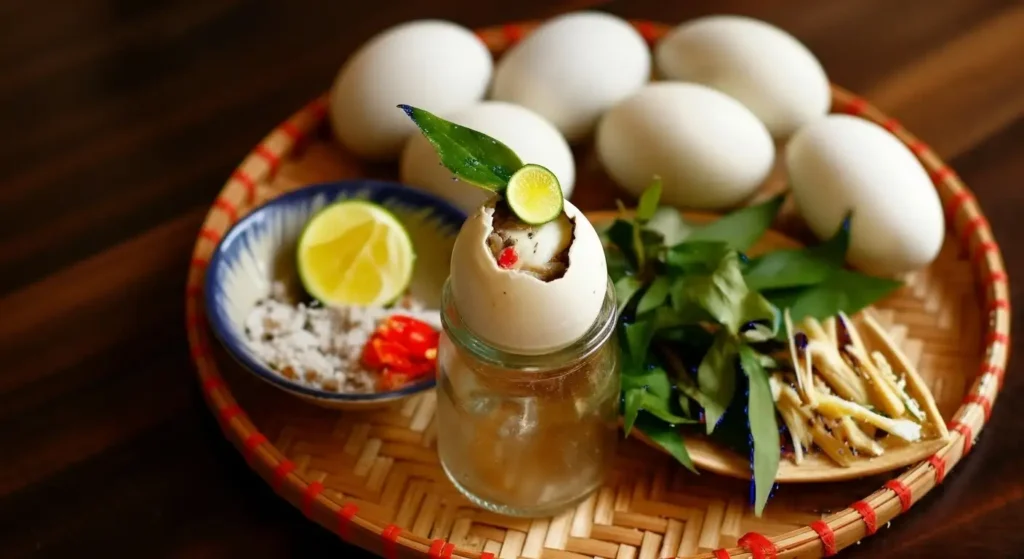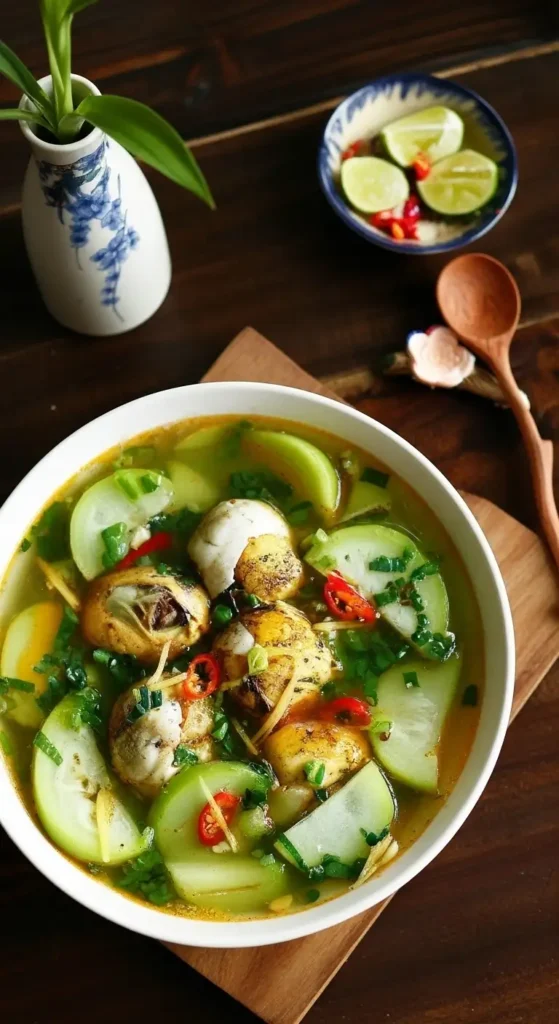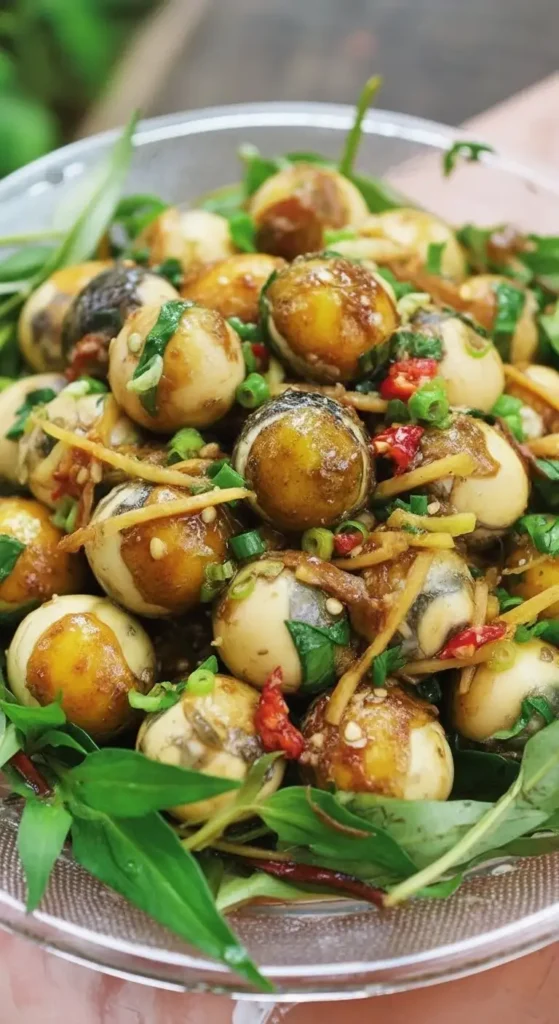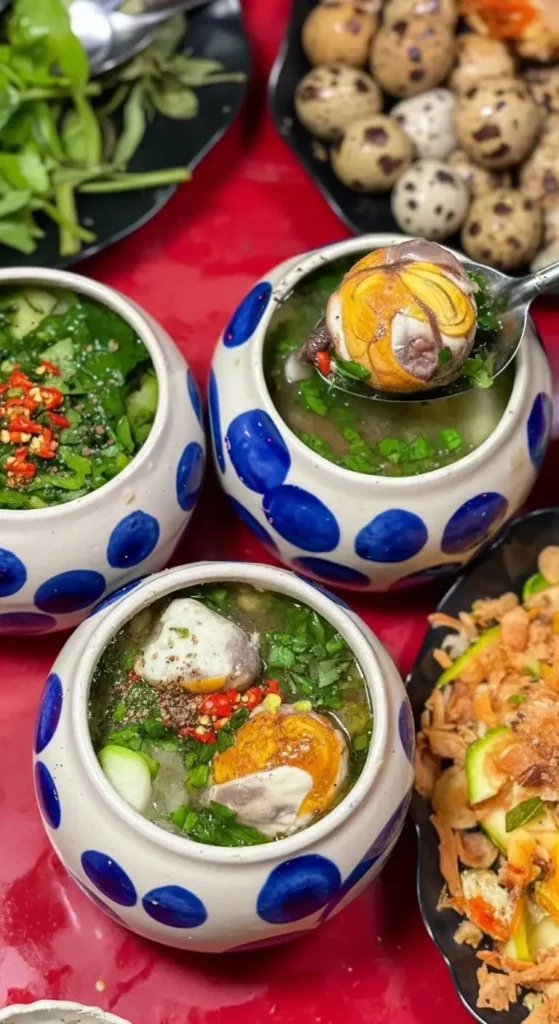Hột Vịt Lộn (pronounced Hut Vitt Lon), known internationally by its Filipino name Balut, is arguably one of Vietnam’s most famous and polarizing street foods. Translating to “fertilized duck egg,” this dish is deeply embedded in Vietnamese culture as a nutritious and warming snack. Its smaller cousin, Cút Lộn (fertilized quail egg), offers a more manageable bite for the curious eater.

Hột Vịt Lộn / Cút Lộn: The Basics
What it is: A fertilized egg (duck or quail) that has been incubated for a specific period—usually between 14 to 21 days—allowing the embryo to partially develop before the entire egg is hard-boiled or steamed.
The Name:
Hột Vịt Lộn / Trứng Vịt Lộn: (Southern/Northern term for) Fertilized Duck Egg.
Hột Cút Lộn / Trứng Cút Lộn: (Southern/Northern term for) Fertilized Quail Egg.
The Flavor: The taste is a complex mix of rich, savory egg yolk, firm egg white (albumen), and the deeply flavorful, chicken-soup-like broth contained within the shell. The embryo itself adds a gamey, umami quality and a varying texture depending on its development stage.
Cultural Significance: In Vietnam, it is considered a very healthy, protein-rich, and “heating” food (following the Đông Y/Yin-Yang philosophy) that is often consumed to restore vitality, especially for pregnant women or those seeking strength.
Culinary Varieties of Hột Vịt Lộn / Cút Lộn
While the classic boiled version is the most common, Vietnamese cuisine has adapted this ingredient into several popular street food dishes:
| Vietnamese Name | Key Ingredients/Method | Notes |
|---|---|---|
| Hột Vịt Lộn Luộc | Classic boiled egg | The traditional preparation, served hot right in the shell. |
| Cút Lộn Luộc | Boiled fertilized quail egg | A miniature version, popular as a fast, easy snack. |
| Hột Vịt Lộn Xào Me | Duck Egg stir-fried with Tamarind Sauce | The boiled egg is peeled, then stir-fried in a thick, tangy, and sweet tamarind sauce, often topped with peanuts and herbs. A highly popular variation, especially in the South. |
| Cút Lộn Xào Me | Quail Egg stir-fried with Tamarind Sauce | The small quail eggs are perfect for this preparation, offering a bite-sized mix of sweet, sour, and savory. |
| Hột Vịt Lộn Chiên Mắm Hành | Duck Egg fried with Fish Sauce and Scallions | The egg is lightly fried or simmered in a savory, aromatic sauce of fish sauce, sugar, and scallion oil. |
| Lẩu Trứng Vịt Lộn | Balut Hot Pot | A unique hot pot where the eggs (usually with some meat) are cooked in a savory broth, popular in colder weather or for group dining. |

How to Eat Hột Vịt Lộn / Cút Lộn
Eating the classic boiled egg follows a specific ritual to maximize the experience:
Preparation: The hot egg is placed upright in a small egg cup or bowl (widest part facing up).
The Crack: Use a small spoon to gently tap and crack a small, circular hole into the shell’s wider end.
The Sip (The Broth): Carefully peel away a small portion of the shell and the membrane. The first step is to gently sip the savory, warm, chicken-like embryonic broth directly from the shell.
Seasoning: Add a pinch of the accompanying seasonings—typically a mix of salt, pepper, and lime or kumquat juice (muối tiêu chanh/tắc)—into the remaining egg content.
The Bite (The Solids): Use the spoon to scoop out and eat the rest of the contents: the rich yolk, the embryo (which ranges from soft to slightly bony/chewy depending on incubation age), and the dense white albumen (often discarded by beginners as it can be tough).
The Herb: Each bite of the egg solids is essentialy chased with a piece of Rau Răm (Vietnamese Coriander). This strongly aromatic, peppery herb is crucial for balancing the “coldness” of the egg and cutting through its richness, adhering to the traditional Yin-Yang balance in Vietnamese cuisine.
Regional Differences
The way Hột Vịt Lộn is consumed varies significantly across the three main regions of Vietnam, particularly in terms of time of day and presentation.
| Region | Regional Term / Usage Time | Presentation & Accompaniments |
|---|---|---|
| Northern Vietnam (Bắc) | Trứng Vịt Lộn (preferred term). Usually eaten as a Breakfast item or a warm midday snack. | Served in a small bowl. The entire egg is often cracked open and peeled into the bowl. The person adds the salt, pepper, and rau răm to the solids before eating. The focus is on a simpler, savory seasoning. |
| Central Vietnam (Trung) | Trứng Vịt Lộn. Focuses on adding more sauces and spices to mask the egg's distinct smell and flavor, reflecting the Central region's love for intensity and heat. | More emphasis on a spicier sauce compared to the North, often incorporating chili paste or a more robust dipping mixture to enhance the flavor profile. |
| Southern Vietnam (Nam) | Hột Vịt Lộn (preferred term). Most popular as a Night Snack or late-afternoon street food. | Served upright in a small cup or egg holder. Only the top of the shell is cracked and removed, allowing the eater to drink the broth first, similar to eating ice cream in a cup. The Southern accompaniment (muối tiêu chanh/tắc) is typically richer in lime/kumquat and often has a hint of sweetness. This region also features the most variations (Xào Me, Chiên Mắm Hành). |




